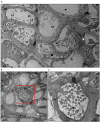A Significantly High Abundance of " Candidatus Liberibacter asiaticus" in Citrus Fruit Pith: in planta Transcriptome and Anatomical Analyses
- PMID: 34177866
- PMCID: PMC8225937
- DOI: 10.3389/fmicb.2021.681251
A Significantly High Abundance of " Candidatus Liberibacter asiaticus" in Citrus Fruit Pith: in planta Transcriptome and Anatomical Analyses
Abstract
Huanglongbing, a highly destructive disease of citrus, is associated with the non-culturable phloem-limited α-proteobacterium "Candidatus Liberibacter asiaticus" (CLas). The distribution patterns of CLas in infected plant are variable and not consistent, which make the CLas detection and characterization more challenging. Here, we performed a systemic analysis of CLas distribution in citrus branches and fruits of 14 cultivars. A significantly high concentration of CLas was detected in fruit pith (dorsal vascular bundle) of 14 citrus cultivars collected at fruit maturity season. A 2-year monitoring assay of CLas population in citrus branches of "Shatangju" mandarin (Citrus reticulata Blanco "Shatangju") revealed that CLas population already exhibited a high level even before the appearance of visual symptoms in the fruit rind. Quantitative analyses of CLas in serial 1.5-cm segments of fruit piths showed the CLas was unevenly distributed within fruit pith and tended to colonize in the middle or distal (stylar end) regions of pith. The use of CLas-abundant fruit pith for dual RNA-seq generated higher-resolution CLas transcriptome data compared with the leaf samples. CLas genes involved in transport system, flagellar assembly, lipopolysaccharide biosynthesis, virulence, stress response, and cell surface structure, as well as host genes involved in biosynthesis of antimicrobial-associated secondary metabolites, was up-regulated in leaf midribs compared with fruit pith. In addition, CLas infection caused the severe collapse in phloem and callose deposition in the plasmodesmata of fruit pith. The ability of fruit pith to support multiplication of CLas to high levels makes it an ideal host tissue for morphological studies and in planta transcriptome analyses of CLas-host interactions.
Keywords: Candidatus Liberibacter asiaticus; anatomical analyses; citrus huanglongbing; fruit pith; high abundance; in planta transcriptome.
Copyright © 2021 Fang, Guo, Zhao, Li, Liao, Deng, Xu and Zheng.
Conflict of interest statement
The authors declare that the research was conducted in the absence of any commercial or financial relationships that could be construed as a potential conflict of interest.
Figures








Similar articles
-
An Overview of the Mechanisms Against "Candidatus Liberibacter asiaticus": Virulence Targets, Citrus Defenses, and Microbiome.Front Microbiol. 2022 Mar 10;13:850588. doi: 10.3389/fmicb.2022.850588. eCollection 2022. Front Microbiol. 2022. PMID: 35391740 Free PMC article. Review.
-
Integrated bacterial transcriptome and host metabolome analysis reveals insights into "Candidatus Liberibacter asiaticus" population dynamics in the fruit pith of three citrus cultivars with different tolerance.Microbiol Spectr. 2024 Apr 2;12(4):e0405223. doi: 10.1128/spectrum.04052-23. Epub 2024 Mar 5. Microbiol Spectr. 2024. PMID: 38440971 Free PMC article.
-
Biological Features and In Planta Transcriptomic Analyses of a Microviridae Phage (CLasMV1) in "Candidatus Liberibacter asiaticus".Int J Mol Sci. 2022 Sep 2;23(17):10024. doi: 10.3390/ijms231710024. Int J Mol Sci. 2022. PMID: 36077424 Free PMC article.
-
Integrated Transcriptome and Metabolome Analysis Reveals Phenylpropanoid Biosynthesis and Phytohormone Signaling Contribute to "Candidatus Liberibacter asiaticus" Accumulation in Citrus Fruit Piths (Fluffy Albedo).Int J Mol Sci. 2022 Dec 9;23(24):15648. doi: 10.3390/ijms232415648. Int J Mol Sci. 2022. PMID: 36555287 Free PMC article.
-
Progress and Obstacles in Culturing 'Candidatus Liberibacter asiaticus', the Bacterium Associated with Huanglongbing.Phytopathology. 2019 Jul;109(7):1092-1101. doi: 10.1094/PHYTO-02-19-0051-RVW. Epub 2019 Jun 3. Phytopathology. 2019. PMID: 30998129 Review.
Cited by
-
An Overview of the Mechanisms Against "Candidatus Liberibacter asiaticus": Virulence Targets, Citrus Defenses, and Microbiome.Front Microbiol. 2022 Mar 10;13:850588. doi: 10.3389/fmicb.2022.850588. eCollection 2022. Front Microbiol. 2022. PMID: 35391740 Free PMC article. Review.
-
Exploring the Genetic Networks of HLB Tolerance in Citrus: Insights Across Species and Tissues.Plants (Basel). 2025 Jun 11;14(12):1792. doi: 10.3390/plants14121792. Plants (Basel). 2025. PMID: 40573779 Free PMC article.
-
Molecular signatures between citrus and Candidatus Liberibacter asiaticus.PLoS Pathog. 2021 Dec 9;17(12):e1010071. doi: 10.1371/journal.ppat.1010071. eCollection 2021 Dec. PLoS Pathog. 2021. PMID: 34882744 Free PMC article. Review.
-
Integrated bacterial transcriptome and host metabolome analysis reveals insights into "Candidatus Liberibacter asiaticus" population dynamics in the fruit pith of three citrus cultivars with different tolerance.Microbiol Spectr. 2024 Apr 2;12(4):e0405223. doi: 10.1128/spectrum.04052-23. Epub 2024 Mar 5. Microbiol Spectr. 2024. PMID: 38440971 Free PMC article.
-
Whole genome sequences of 135 "Candidatus Liberibacter asiaticus" strains from China.Sci Data. 2024 Sep 19;11(1):1018. doi: 10.1038/s41597-024-03855-3. Sci Data. 2024. PMID: 39300139 Free PMC article.
References
-
- Achor D. S., Etxeberria E., Wang N., Folimonova S. Y., Chung K. R., Albrigo L. G. (2010). Sequence of anatomical symptom observations in citrus affected with huanglongbing disease. Plant Pathol. J. 9 56–64. 10.3923/ppj.2010.56.64 - DOI
LinkOut - more resources
Full Text Sources

